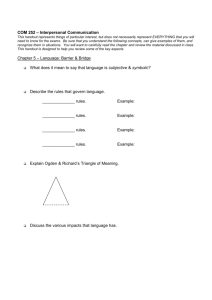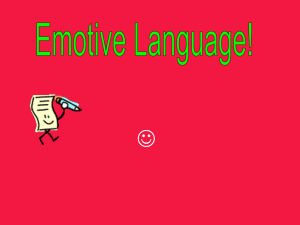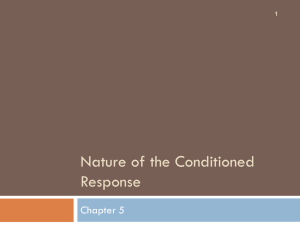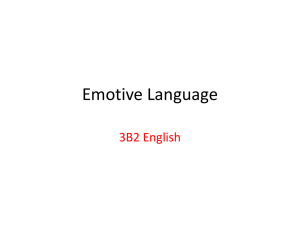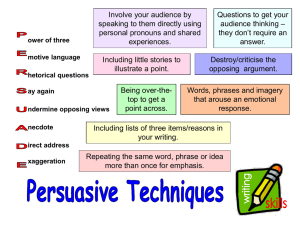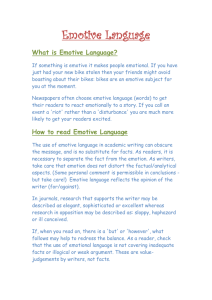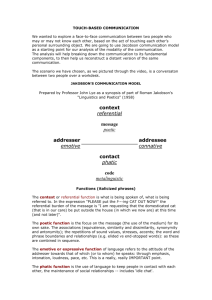The Language of Deception
advertisement
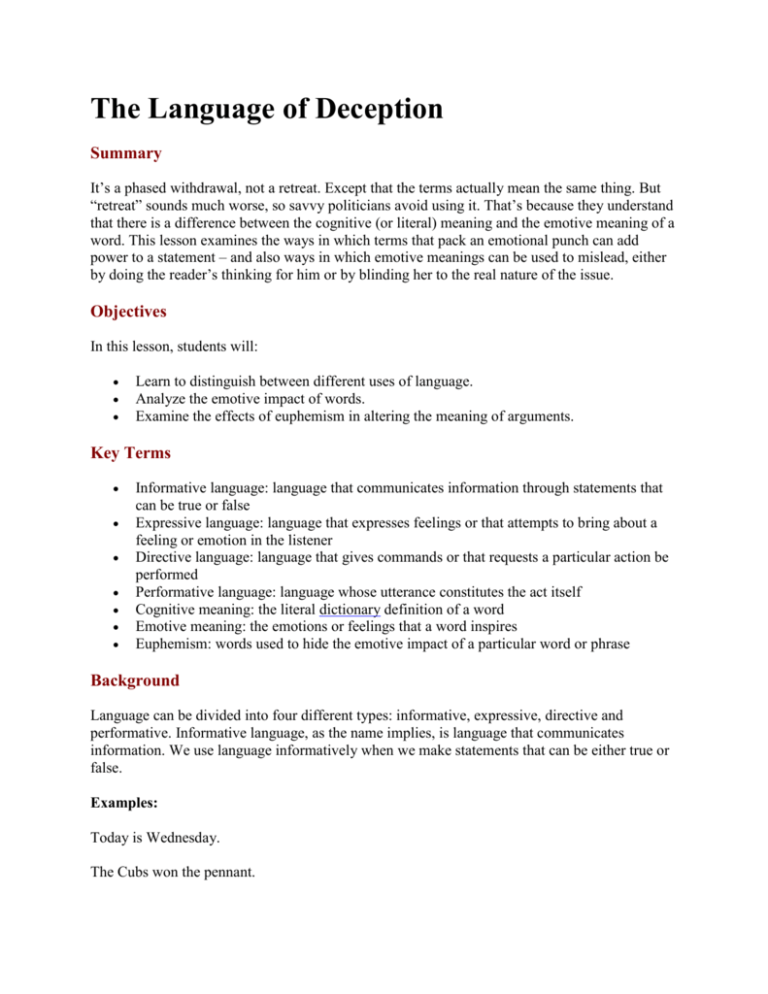
The Language of Deception Summary It’s a phased withdrawal, not a retreat. Except that the terms actually mean the same thing. But ―retreat‖ sounds much worse, so savvy politicians avoid using it. That’s because they understand that there is a difference between the cognitive (or literal) meaning and the emotive meaning of a word. This lesson examines the ways in which terms that pack an emotional punch can add power to a statement – and also ways in which emotive meanings can be used to mislead, either by doing the reader’s thinking for him or by blinding her to the real nature of the issue. Objectives In this lesson, students will: Learn to distinguish between different uses of language. Analyze the emotive impact of words. Examine the effects of euphemism in altering the meaning of arguments. Key Terms Informative language: language that communicates information through statements that can be true or false Expressive language: language that expresses feelings or that attempts to bring about a feeling or emotion in the listener Directive language: language that gives commands or that requests a particular action be performed Performative language: language whose utterance constitutes the act itself Cognitive meaning: the literal dictionary definition of a word Emotive meaning: the emotions or feelings that a word inspires Euphemism: words used to hide the emotive impact of a particular word or phrase Background Language can be divided into four different types: informative, expressive, directive and performative. Informative language, as the name implies, is language that communicates information. We use language informatively when we make statements that can be either true or false. Examples: Today is Wednesday. The Cubs won the pennant. Blue cheese is tangy. Heroin addiction is bad. Arguments are always comprised of sentences that use language informatively. But of course not all sentences are informative. Some are expressive, meaning that they use language in a poetic fashion. Expressive language is intended to express feelings and attitudes. That expressive function might be intended to describe one’s own feelings or to trigger a certain emotion in others. Examples: Shall I compare thee to a summer’s day? Now everybody do the propaganda./And sing along to the age of paranoia. In came Mrs. Fezziwig, one vast substantial smile. Kobe has the hot hand. Expressive language is not meant to be taken literally, nor is it meant to convey information, although it sometimes does. Language might also be used directively. Directive language attempts to motivate some sort of action, either positive or negative. Usually, directives consist of commands or requests for action. Examples: Shut the door. Thou shalt not steal. Walking on the grass is strictly forbidden. Beware of dog. And finally, some language is used performatively. Performative uses of language are those uses in which the saying constitutes the action. A judge who says, ―I hereby sentence you to prison for a term of no less than 20 years and no more than the end of your natural life,‖ has in uttering the sentence actually performed the action. Similarly, the sentence, ―I apologize for my behavior,‖ actually constitutes the apology. Examples: I now pronounce you man and wife. I forgive you. Bless you. You are under arrest. Real-life sentences, however, are rarely quite so cut-and-dried. In fact, a great many sentences contain elements of several different kinds of language. Consider this sentence: Get your butt over here, you lazy jerk! This sentence is informative in that it is expressing a proposition that could be true or false (i.e., ―You are a lazy jerk‖). It is also directive insofar as it gives a command (i.e., ―Get your butt over here‖). And it is expressive in that it conveys the speaker’s attitude toward the target of the sentence (i.e., ―I’m quite irritated with you‖). In effect, the sentence is really a condensed version of three distinct propositions: Get over here. I’m quite irritated with you. You are lazy. We can accomplish so much with so few words because words have two different kinds of meanings. The first is a cognitive (literal) meaning, or the sort of meaning that one finds in the dictionary. But words also have emotive meaning, a term that refers to the emotional impact that a word might have. Words like ―oppression,‖ ―fool‖ and ―Nazi‖ have negative emotive overtones (meaning that most people react negatively to them) while words like ―free,‖ ―spring‖ and ―satisfaction‖ have positive overtones. Some words, such as ―socialism,‖ ―marijuana‖ and ―God,‖ have mixed emotive overtones (some people react positively to them while others react negatively). Words like ―is,‖ ―car‖ and ―prospective‖ have neutral overtones. Emotive meanings can be used for good or for ill. Con artists, for example, may use the emotive side of language (a) to mask cognitive meaning by whipping up emotions so that reason is overlooked and (b) to dull the force of language so as to make acceptable what otherwise might not be. The latter task is often accomplished by means of euphemisms, which are less offensive or duller expressions used in place of more offensive or emotively charged locutions. There are lots of these that we use every day. Examples: Fired / Laid off or downsized Died / Passed away Land mines / Area denial munition Unemployed / Job seeker Genocide / Ethnic cleansing Prison / Internment camp Fat / Full-figured Liberal / Progressive Now, emotive language is not bad in and of itself. Indeed, sometimes the emotive impact of language is crucially important. But we should be aware that emotive language can cloud good reasoning. Some emotionally loaded words can distract us from the real claims being made. Truly loaded language is highly unlikely to help at all. Consider, for instance, the following: George Bush has been endorsed by a number of conservative Evangelical Christians. George Bush has been endorsed by right-wing, fascist Bible-thumpers. Both sentences convey the information that conservative Christian activists have endorsed George Bush. The first sentence does so in a neutral way, while the second does so in a very emotionally loaded manner. The second sentence does little to produce reasoned discourse. Procedure Materials 1. Text of Cohen v. California. 2. Student handout #1: Uses of Language. 3. Student handout #2: Examples of Emotive Language. Exercises Exercise #1 – The Emotive Power of Words To the teacher: Constitutional law scholars frequently consider Cohen v. California, 403 U.S. 15 (1971), to be among the most important Supreme Court decisions on free speech. At its heart, the case is about the relationship between profanity and free speech. The Court specifically examines the emotive impact of profanity and argues that the emotive impact of the profanity was an important part of the political nature of the speech in question. The topic does, however, require some delicacy. Discussion can take place in small groups, though many teachers may prefer to conduct a class-wide discussion so as to ensure that students do not take the case as a license to swear freely. Teachers may also wish to advise students that in Hazelwood School District v. Kuhlmeier (1988), the Court ruled that high school students do not have unrestricted free speech rights. Disruptive speech can still legally be censored. At the height of the Vietnam War, Paul Robert Cohen was arrested for wearing a jacket that read ―F— the Draft‖ (though the uncensored version of the profanity was on Cohen’s jacket). Cohen appealed his conviction for disturbing the peace all the way to the Supreme Court. He won. In Cohen v. California, Justice John Marshall Harlan (writing for the Court) noted that the profane word carried a significant emotive impact that was a crucial part of the message. Read through the case and, with students in small groups or with the class as a whole, discuss the following questions: Justice Harlan argues that ―words are often chosen as much for their emotive as their cognitive force. We cannot sanction the view that the Constitution, while solicitous of the cognitive content of individual speech, has little or no regard for that emotive function which, practically speaking, may often be the more important element of the overall message sought to be communicated.‖ Do you agree that the emotive force of the profanity on Cohen’s jacket is an important part of his overall message? Is there a way to rewrite the message on Cohen’s jacket in such a way as to retain its power without resorting to profanity? Exercise #2 – Think About Language…or Else Language Might Think for You To the teacher: Emotive meanings of words are an important part of communication, but they also carry risks. Unscrupulous pitchmen can use the emotive meanings of words to mask their true intentions. When a politician frames an argument in excessively patriotic terms, an unwary reader might be led to support that position without examining the details. Look at the arguments on student handout #2, Examples of Emotive Language. Divide students into small groups of 3 to 4. Assign each group a passage. Have the students identify the emotive language in the passage. Then ask students to rewrite the passage with emotively neutral terms. Ask the groups to share their revisions with the rest of the class. Exercise #3 – Detecting Euphemism To the teacher: The words that we choose are important for more than just their literal meanings. Words can have emotional impacts as well and those emotional impacts can sometimes change the meaning of an argument. Language can also be used to sway inattentive readers. Euphemism can mask the badness of an act – or it can just as easily paint neutral ideas in much darker shades. Students are often not consciously aware of the impact that certain words have on them. A more analytical approach to language can help us to avoid potential pitfalls in reasoning. Divide the class into groups of 3 to 4 students and have each group use the Internet to research one of the following euphemisms: 1. 2. 3. 4. Soft targets (military euphemism) Outsourcing (corporate euphemism) Urban (social/cultural euphemism) Enemy combatants (legal euphemism) 5. Physical persuasion (law enforcement / military euphemism) In performing their research, students should ask the following questions: What does the term/phrase actually mean? Where does it originate? Is the term/phrase more or less neutral than the term it replaced? Find some examples of arguments that make use of the term. Why do you think that the speaker chose that particular phrase rather than some other phrase? Why do you think that the speaker is using the phrase? Ask the students to report their findings to the class. About the Author Joe Miller received his Ph.D. in philosophy from the University of Virginia. He is a staff writer at FactCheck.org, a project of the University of Pennsylvania’s Annenberg Public Policy Center. Prior to joining FactCheck, he served as an Assistant Professor of Philosophy at West Point and at the University of North Carolina at Pembroke, where he taught logic, critical thinking, ethics and political theory. The winner of an Outstanding Teacher award at UNC-Pembroke and an Outstanding Graduate Teaching Assistant award at the University of Virginia, Joe has over 10 years of experience developing curricula. He is a member of American Philosophical Association and the Association for Political Theory. Correlation to National Standards National Social Studies Standards X. Civic Ideals and Practices Social studies programs should include experiences that provide for the study of the ideals, principles, and practices of citizenship in a democratic republic. Essential Skills for Social Studies Acquiring Information A. Reading Skills 1. Comprehension 2. Vocabulary B. Study Skills 1. Find Information 2. Arrange Information in Usable Forms C. Reference & Information-Search Skills 2. Special References D. Technical Skills Unique to Electronic Devices 1. Computer Organizing and Using Information A. Thinking Skills 1. Classify Information 2. Interpret Information 3. Analyze Information 4. Summarize Information 5. Synthesize Information 6. Evaluate Information B. Decision-Making Skills C. Metacognitive Skills Interpersonal Relationships & Social Participation A. Personal Skills C. Social and Political Participation Skills Democratic Beliefs and Values B. Freedoms of the Individual C. Responsibilities of the Individual National Mathematics Standards Process Standards Reasoning and Proof Standard National Educational Technology Standards 2. Make informed choices among technology systems, resources, and services. 7. Routinely and efficiently use online information resources to meet needs for collaboration, research, publication, communication, and productivity. 8. Select and apply technology tools for research, information analysis, problem solving, and decision making in content learning. Information Literacy Standards Information Literacy Standard 1 assesses information efficiently and effectively. Standard 2 evaluates information critically and competently. Standard 3 uses information accurately and creatively. Social Responsibility Standard 7 recognizes the importance of information to a democratic society. Standard 8 practices ethical behavior in regard to information and information technology. Standard 9 participates effectively in groups to pursue and generate information. English Language Arts Standards Standard 1 Students read a wide range of print and non-print texts to build an understanding of texts, of themselves, and of the cultures of the United States and the world; to acquire new information; to respond to the needs and demands of society and the workplace; and for personal fulfillment. Among these texts are fiction and nonfiction, classic and contemporary work. Standard 3 Students apply a wide range of strategies to comprehend, interpret, evaluate, and appreciate texts. They draw on their prior experience, their interactions with other readers and writers, their knowledge of word meaning and of other texts, their word identification strategies, and their understanding of textual features (e.g., sound-letter correspondence, sentence structure, context, graphics). Standard 5 Students employ a wide range of strategies as the write and use different writing process elements appropriately to communicate with different audiences for a variety of purposes. Standard 6 Students apply knowledge of language structure, language conventions (e.g., spelling and punctuation), media techniques, figurative language, and genre to create, critique, and discuss print and non-print texts. Standard 7 Students conduct research on issues and interests by generating ideas and questions, and by posing problems. They gather, evaluate, and synthesize data from a variety of sources (e.g., print and non-print texts, artifacts, people) to communicate their discoveries in ways that suit their purpose and audience. Standard 8 Students use a variety of technological and information resources (e.g., libraries, databases, computer networks, video) to gather and synthesize information and to create and communicate knowledge. Standard 12 Students use spoken, written, and visual language to accomplish their own purposes (e.g., for learning, enjoyment, persuasion, and the exchange of information).
